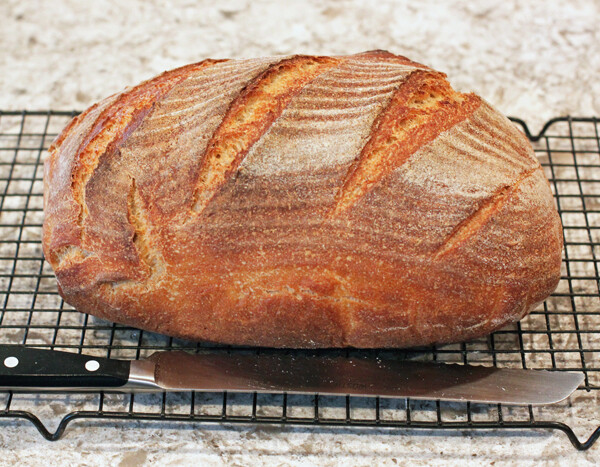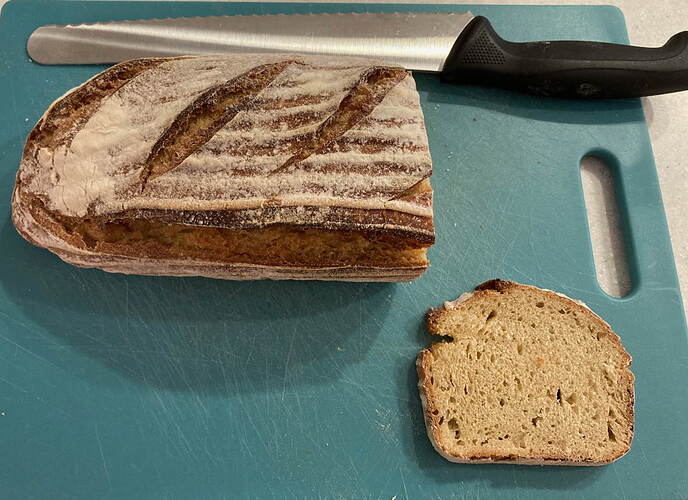Ok I’m depressed, first time making sourdough no knead bread, thought it had risen well but when baked, flat as a pancake!! i am a beginner definitely, one thing I noted the dough was really wet and sticky, a bit better after 12 hour proofing but then still very sticky…any ideas??
Nice rise but with flat results usually means over fermentation. If your 12 hours was in warm temps or your starter very active, the dough probably used too much of the “food.” Try letting the dough expand less in the bowl by about 20%. This could be a range of time, depending on if you keep the dough cooler or use a less starter.
Thanks Melissa for the information? Another question for you…can you use your sourdough starter that is with whole wheat flour and use it for a white sourdough bread?
Yes, starter can change food source like that with no problem. You can even launch the fermentation of vegetables with sourdough starter.
Here’s an experiment I did trying to see the impact of different starters in doughs of the same flour ratios:
Thanks for your help melissa this is definitely a journey. Im trying to find a no knead white sourdough recipe but cant seem to find one on your site? I have ordered your book as well which will help my knowledge base but would like to try again and i think would prefer the white sourdough if you can point me in the recipe direction. Janet
Thanks for the help Abe much appreciated. I will give it a try!!
Its quite high hydration but it needs to be if it’s no knead. Whatever happens if you dump it in a loaf pan it will work and be delicious. If its fermented right and the gluten is fully formed then it should make it easier to handle. Try the plain one as the other is a conversion for add-ins. Good luck.
Thanks Abe, i will give it a try im a novice so we will see how it turns out for me!!
Using this recipe with all white flour is fine as long as you reduce the water. White flour absorbs less water than whole wheat flour. With kneading/gluten development, a wet white dough can be manageable, but you’re not aiming to do all those dough interventions right now so I’d stay under 75% hydration.
Abe is recommending 70% hydration, which should definitely feel manageable. Over time you’ll get a feel for what % feels good to you with which flours.
Hydration % is water divided by flour.
Eric’s No Knead Sourdough is
438g water / 520g flour = 0.84 or 84%
(Because half the flour is whole grain, it probably feels like 78% hydration in an all white dough.)
The no knead variation Abe just linked you to is
350g water / 500g flour = 0.70 or 70%
The neat thing about No Knead recipes is that you can easily see how much your dough has risen. In contrast, when you stretch and fold the dough a bunch, this is harder to see unless you use an aliquot jar (search the forum on that term if you’re inclined : )
I just added a photo gallery to a recipe, with “before and after” dough expansion photos of a no knead variation. I think I took the fermentation a little too far (warm lit oven rise, more than doubled), but I refrigerated the proofing basket immediately and loved the results.
I almost forgot to add thank you for getting the book! There is a white no knead (first recipe) and a lot of tips, including how to make any of the recipes more or less whole grain. Eric and I are always here to answer questions you have about the recipes too.
Yes im looking forward to the book coming!! Feeling a little shell shocked with my first flop atttempt can only get better! Im still working so will have to wait for Friday night to try the white sourdough recipe will keep you posted.
Hi Melissa and Eric, I received your book and am finding it very helpful, thankyou! i just baked my first loaf of No Knead sourdough with white flour and success not perfect but better than my first loaf of bread last week even tastes good! I think the most difficult part for me is figuring out when it is ready to bake in the final proof!! Our house tends to be around 72degrees but since we have snow now which is unusual!! for Vancouver island the wood stove is making it warmer in the house. i ended up proofing for just over 2 hours not sure maybe I should have waited not sure?
It’s very hard in the beginning to know when to put the dough in the oven. I never found the poking test to be particularly helpful, but it can’t hurt to do. (Gently poke the dough with your finger, and if the dough doesn’t spring back, it’s ready or past ready to bake.)
Keep observing the dough before you put it in the oven, and the results you get when you take it out. Eventually, you’ll develop a sense of what proofing appearance/time/temp gets you what results.
Edited to add this advice I just gave in a different thread 
There are a lot of recipes with before and after photos of the bulk and the final proof in the Breadtopia blog. Scroll to the photo gallery after the printable recipe in this one for example. You can see some expansion in the basket, but not a lot.
Hello davehames,
That’s a lovely-looking loaf, both crust & crumb. What were the flour & water proportions for this, and types of flour? Thanks for sharing! ~ Patricia
Hello Eric, does oil also promote potential burning?..I did that once, but never again!
Also, do I understand correctly that parchment paper typically is used specifically for wet doughs?..like no-knead breads, to transfer from worksurface to baking vessel.
And is parchment paper not necessary for other bread doughs with less hydration?
Thanks for clarifying! ~ Patricia
omgosh, that lovely lava-like crust!
PLBT, I use 16 oz bread flour, 8 oz fresh milled whole wheat flour (white or red), 16 oz water, 2 tsp salt and 1/3 cup starter. It winds up with 67% hydration this way. The Yecora Rojo wheat makes a great tasting flour for this bread too. I had to increase the baking times for the extra dough. I bake it covered for 45 minutes in a 475°F oven, then cover it and drop the oven down to 450°F for 10 or 15 more minutes until done.

In an abomination of the scientific method I altered a number of variables of v1 of the no knead recipe. In order to hone in on the main problems early, can y’all suggest which might be the most relevant for the closed crumb?
From my notes:
NOTES
3/13/21 - used einkorn ( half WW, half AP) instead of reg WW. Used KA mixer, rest 15-20 min then dough hook for 1-2 min, rest 20 min repeat dough hook, scrape together and let sit covered over night. VERY, VERY wet dough. Surfaces exudes microdroplets of water. I had to add lots (½ cup +) after bulk to handle. Cooked in hot elongate covered clay bread pan after > 90 min proof. Removed from oven at 208 degF. - Closed crumb with holes at periphery. Mildly overly moist. Great looking crust. Tangy (not to my taste) Not as tasty as spelt. Starter from fridge fed 5-6 hours and left at room temp. - not especially bubbly.
- Apparently einkorn is low gluten so maybe that was the problem.
Thanks,
David - Dallas
@davidwat Good morning, David. The following website is one of the best I’ve found for “all things einkorn.” There are video tutorials on how to build and grow your own einkorn sourdough starter to baking beautiful loaves of einkorn bread. I hope this helps. https://jovialfoods.com/
Baking blessings,
Leah
